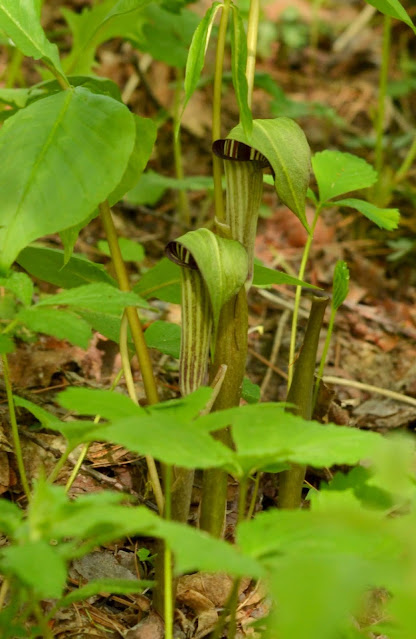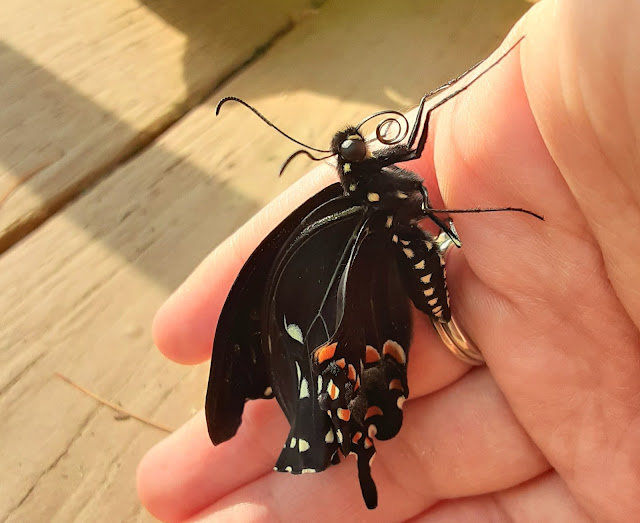Here we are, on the very last day of 2022 (happy almost-new-year!), and it's finally time to catch up with this year's sightings that have been gathering on my computer since March. I took fewer pictures than usual this year, mostly because my beloved camera -- which has seen a ton of use since I got it in 2011 -- simply hasn't been working very well anymore. A new camera is now waiting in the wings, ready to take over in 2023, and I'm super excited to make good use of this new toy. For this year, though, I've made do with my declining SLR camera and the less-than-ideal camera on my phone. Even so! There were a lot of really cool animals and plants on our property this year, and I'm happy to be able to share some highlights from 2022. We had a great deal of activity from our resident summer birds, so I'll start there!
Eastern Phoebes are some of my favorite yearly neighbors, and they were back and raising babies again this year. This was the first year since we moved into this house in 2017, though, that the phoebes didn't build a nest above our front door, and I very much missed having these wonderful birds so close by. (I wonder if the female who usually built the nest at that location is no longer alive....) Instead, the phoebes re-used a nest they built a couple of years ago in the rafters of an old shed on our property, and they raised two broods this year in that nest. Well, almost two broods. The first smooth-white Eastern Phoebe egg appeared in the nest on April 24, and on April 26 there was a speckled Brown-headed Cowbird egg in the nest, too. This is the second year I've seen one of our phoebe nests parasitized by cowbirds, and cowbirds need to live, too. I mean, really, it's pretty amazing that this is their method for raising young; that is, leave it to someone else. In any case, this situation didn't work out well for the phoebes this year. On May 12, the cowbird chick hatched while the phoebes were still in their eggs:
And on May 16, the cowbird chick was huge compared to the one phoebe chick that hatched:
As far as I could tell, the cowbird chick grew up successfully, and no phoebe chicks made it out of that brood. Pretty much immediately after the cowbird fledged, though, the phoebe parents got to work with a new batch of eggs in the same nest. By June 19, they had a nice second brood of phoebe babies:
All of that second brood fledged successfully, so that's a few new Eastern Phoebes in the world, at least!
Only one of our two nest boxes got used this year, first by a family of Tree Swallows -- I'm so happy to see these birds returning to nest in our meadow every year -- and then by a family of House Wrens after the Tree Swallows vacated the box and I cleared out their nest. Here's the lovely collection of Tree Swallow eggs in their feather-lined nest on May 14:
On May 10, I watched a Black-capped Chickadee gathering big beakfuls of moss in the woods and bringing them to a likely nesting spot in a hollowed-out tree right next to the path:
So much moss for such a little bird!
A hole in the chosen tree was fairly well overflowing with moss:
Here's the chickadee perched above the moss-filled hole on May 12 (and it looks like there's some fur in there, too):
I don't know whether the chickadees successfully raised a family in that nesting spot, but it was really cool to see part of the building process, at least.
The Northern Cardinals were super on top of the nesting process, and by May 15 they already had awkward fledglings inching out of their nest in the big fir tree in our back yard:
Wow, baby cardinals look weird! Both of the cardinal parents were on high alert in nearby trees while I was at all in the area. Here's the male cardinal keeping a close watch on me, and looking especially bright against this Shagbark Hickory's newly grown leaves:
On June 19, the cardinals' used nest fell out of its tree, so I got to see this neat construction up close:
Here's the underside of the nest, with wide bark strips from the non-native Beauty Bush (Linnaea amabilis) that grows nearby in the yard:
The same fir tree that hosted the Northern Cardinals in April and May turned out to be quite a popular nesting spot this year, with both Chipping Sparrows and House Finches raising families there later in the summer.
I happened across two Song Sparrow nests on the ground in the meadow this year. I'm not sure whether either of the specific nests I saw were successful, but I saw Song Sparrow fledglings hanging out with their parents in the summer, so something somewhere must have worked out. Here's one bunch of Song Sparrow eggs in their nest on May 25:
A pair of Dark-eyed Juncos had a nest on the narrow strip of sloping ground between our driveway and the road, and somehow they must have managed to protect their nest from the chipmunks and snakes that I often see around here, because on June 4 a couple of baby juncos were hopping around next to our driveway with the anxious parents in close attendance. Here's one of the new babies with its wacky hairdo and tiny stubby tail:
And here's one of the adult juncos foraging a few feet away:
Also near the driveway, the Gray Catbirds built a nest in a tangle of chokecherry shrubs and wild grape vines. The nest was well concealed, so my biggest clue that babies were nearby was the scolding parents. Here's one of the parent catbirds carrying a plump meal to its babies on June 22, and pausing at the top of our arbor (newly added above our front path this year) to yell at me:
This is the best angle I could find to get a glimpse at the catbird babies, and it's not exactly clear, but you can see the bright yellow beak and emerging feathers on one young bird at least; this picture is from June 23:
Those are all the nests I knew about for sure -- and 11 species with confirmed nests on our property is great! Some other birds also made it very clear that our yard was part of their territory, and I hoped that this meant they had families and nests somewhere nearby. The mid-sized apple tree behind our house ended up with a lot of bare branches this year, which made it a great spot to easily see birds. This male Common Yellowthroat sang his somewhat unusual song (with four parts instead of three) from this tree frequently during the summer; here he is on June 23:
I also got used to seeing a male Ruby-throated Hummingbird perched at the very tip of one of this tree's branches pretty much any time I looked at this tree this summer. I don't know for sure that this was always the same individual bird, but this seemed like such consistent behavior that I'm guessing it was a single male. I find it so strange and charming to see such a tiny bird perched so prominently. Here are a few pictures from June 22 and 23:
In this mid-stretch pose, he looks almost ferocious, but adorably so:
Another picture in somewhat better lighting:
I couldn't get enough of this bold little guy:
And here's one more picture of perhaps the same male hummingbird on June 20, because I also love seeing these tiny birds perched on comparatively huge power lines, another common sight in our yard this summer:
On July 17, a Blue-winged Warbler brought its fledglings to our yard while it hunted for caterpillars -- I'm not sure where this family had its nest, but I was glad to see them, since this was my first confirmation that this species breeds somewhere in our neighborhood:
I'm happy that I got to see so much activity from our summer resident birds this year, and I'm also sure that I missed a lot. Why can't I just be outside all the time? In any case, that was 2022's breeding bird highlights! I still have plenty of other sights to share from this year, so keep reading in the next post.













.jpg)




































